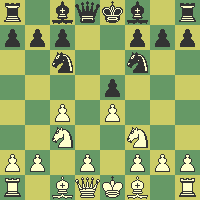
Lake Erie Open, 1980.
White: Dr. Marchand
English Opening.
Black: Col. Sicherman
1. c4 e5.
Played on hazard. No opening I played against Marchand ever seemed to reach equality.
2. Nc3 Nc6; 3. Nf3 Nf6; 4. e4.

A bit unorthodox. Now 4...Bb4 should give Black a comfortable game.
4...d6?! 5. d4 ed; 6. N:d4.
Black is cramped.
6...Be7; 7. Be2 O-O; 8. N:c6!?
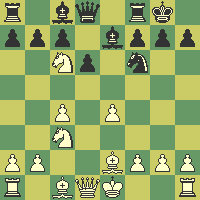
To be able to play Qc2 or Bd3 without ...Nb4.
8...bc; 9. O-O Nd7; 10. f4 Bf6; 11. Be3 Qe7; 12. Qc2 Bb7.
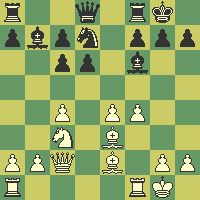
BLack has no good resource against the bind.
13. Bf3 Nb6; 14. b3 Rfe8; 15. Rae1 a5; 16. c5.
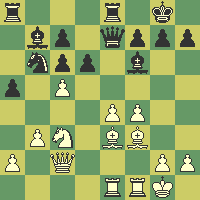
I've had tripled pawns before and survived, but why tempt fate?
16...Nd7; 17. Na4 Ba6; 18. Rf2 Bb5.
Still trying to simplify.
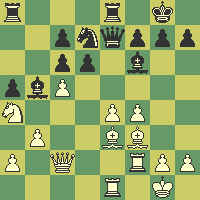
19. cd cd; 20. Rd2 Rad8; 21. Nb6 g6.
This loses a pawn, but I have faint hopes of counterplay.
22. a4 Ba6; 23. Q:c6 N:b6; 24. Q:b6 Bc8; 25. Q:a5.
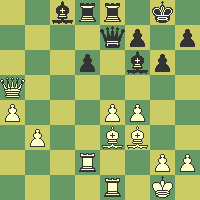
White is ahead by two connected passed pawns. Only tactics can stop him!
25...Be6; 26. e5 de; 27. fe Bg5!
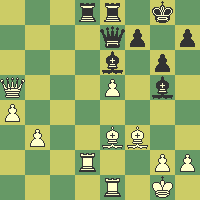
Most players would pronounce this a double error: it trades pieces while behind in material, and it trades a good Bishop instead of a bad one! But in such an extremity it is urgent to break up White's bishop pair. For the first time in the game, Marchand thought at length.
28. B:g5 Q:g5; 29. R:d8 R:d8; 30. Qc3 Rc8.
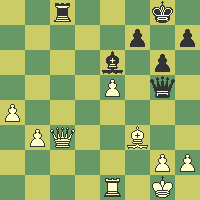
Counterplay bares its teeth.
31. Qe3 Qd8; 32. b4? Rc4.
Here White thought for a long time. Black's initiative is worth more than a pawn!
33. Rd1 Qe7; 34. a5 R:b4; 35. a6 Ra4; 36. Bb7.
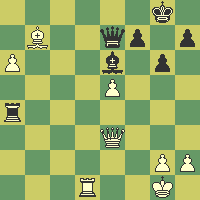
Consolidating just in time. Black now advances steadily.
36...Bg4?!
This is doubtful strategy but it keeps White off balance.
37. Rc1 Ra3; 38. Qf4 (Qd4!) Bf5; 39. h3.
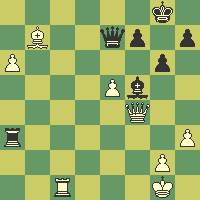
To free White's Rook from guard duty, but it weakens the King's field.
39...Qd8; 40. Kh2 Qb6; 41. Rd1 Qb3!
Simultaneously attacking the Rook and taking control of the third rank.
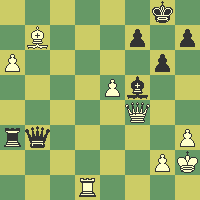
42. Rd2 Kg7; 43. Qh4 Qe3; 44. Qf6+ Kh6; 45. Rd1 Qf2!
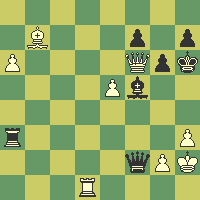
Threatening 46...R:h3#. William R. Tallmadge recommends instead 45...B:h3; 46. Qh4+ Kg7; 47. Re1 (47. Q:h3?? Q:e5+; 48. g3 Qe2+) Qd2; 48. Qf6+ Kg8; 49. Qd6 Q:e1; 50. Q:a3 with reasonable chances for Black. Its main disadvantage would be carrying White past the time control to a quiet position.
The more aggressive 45...Qe2 would allow perpetual check with 46. Qh4+. This would be a reasonable outcome, but I preferred to hold on to the possibility of confusing my opponent into a fatal mistake.
46. Kh1! Qg3; 47. Q:f7 B:h3.
For White still has no mate, and 48. gh Q:h3+; 49. Kg1 Qg4+ costs a Rook.
48. Qf8+ Kg5; 49. Qf6+ Kh6; 50. Bf3.
Threatening 51. Qf8+ winning the Rook. Tallmadge points out that 50. e6 (or 49. e6) should win, since Black also has no mate. The open fifth rank would leave Black no time to pile up on g2.
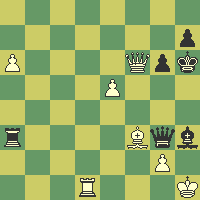
50...Ra2; 51. Rg1 Rf2.
Black's threats never end! This time it's 52...B:g2+; 53. B:g2 (or 53 R:g2 Rf1+ and mates) R:f6; 54. ef Qh4+. Still, 51...Bg4 would have been stronger.
52. Qf8+ Kg5; 53. Qe7+ Kh6; 54. Qf8+.
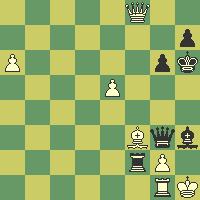
A snap decision in time pressure. It is tempting to advance a pawn instead, but after 54. a7 (or e6) B:g2+; 55. B:g2 Rf5! 56. Rf1 Rh5+; 57. Kg1 Qh2+; 58. Kf2 Qf4+ White must take the perpetual with 59. Kg1.
54...Kg5; 55. Qf6+ Kh6 1/2:1/2.